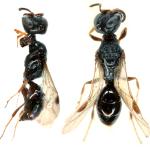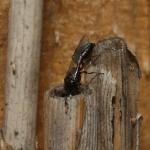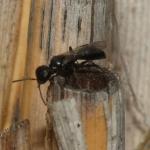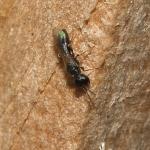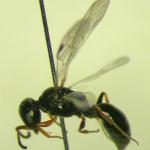Stigmus minutissimus RADOSZKOWSKI 1877; Spilomena vagans BLÜTHGEN 1953
There is some taxonomic uncertainty regarding this, and other, Spilomena species. Research for this Atlas suggests that BWARS initially took an outdated stance in considering this species to be distinct from Spilomena vagans Blüthgen (as per Richards, 1980 and Lomholdt, 1984). Dollfuss (1991), Falk (1991), Vikberg (2000) and Bitsch et al. (2001) all consider the two taxa to be one species: Spilomena troglodytes. This view is also being taken by the UK Species Inventory and implemented by the NBN Gateway. It is now accepted that Spilomena vagans is a synonym of troglodytes and so the Atlas will deal with all records under this latter name.
The highest density of records comes from Surrey and Kent, with increasingly fewer records scattered across East Anglia, the south-west, the Midlands, northern England, and Wales. It is also recorded from Ireland by O’Connor et al. (2009).
This species is known across Europe eastwards to Cyprus, Turkey and Israel (Dolfuss, 1991) and also Kazakhstan and Kyrgyzstan (Bitsch et al., 2001). Lomholdt (1984) (who, as an earlier author, maintained the split into the two taxa discussed above) implies a possible geographical split between the two species, with his vagans being found in all Nordic countries, but not common in the rest of Europe, whilst troglodytes was noted from only a handful of records in Fennoscandia and Denmark but widespread across the rest of the continent. This view that Spilomena vagans is a more Nordic beast is not supported by the stated distribution given by Richards (1980) of South Devon, Bedfordshire and Warwickshire.
This species is not regarded as scarce or threatened and is not listed in Falk (1991), who noted the synonymy. As a separate species, Spilomena vagans was considered to be Rare (RDB3) by Shirt (1987).
Currently BWARS refers to Vikberg's 2000 treatment of Spilomena
V. V. Vikberg, “A re-evaluation of five European species of Spilomena with a key to European species and relevance to the fauna of North Europe, especially Finland (Hymenoptera: Pemphredonidae)”, Entomologica Fennica, vol. 11, pp. 35-55, 2000
This species might be encountered wherever suitable nesting sites are available.
May to September, according to Richards (1980).
In keeping with the genus as a whole, the cells are stocked with nymphs of thrips (Thysanoptera). Lomholdt (1984) noted that 50–60 thrips may go to provision just one cell.
All literature sources indicate the use of old wood-worm borings in standing dead wood are the favoured nest sites, although the use of roofing thatch is also mentioned, along with abandoned tunnels in Bramble stems.
No data available.
No data available.
2016


